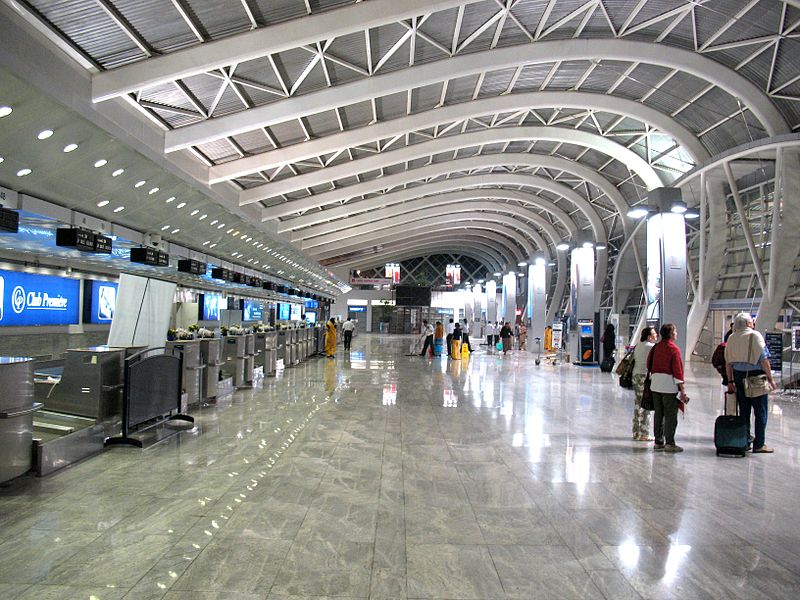Public transport systems in Mumbai include the Mumbai Suburban Railway, Brihanmumbai Electric Supply and Transport (BEST) buses, taxis, auto rickshaws, ferries, and aeroplanes, and plays a dominant role. Rail and bus services combined carry about 88% of the passenger traffic.[172] Black and yellow metered taxis traverse most of the metropolis. Auto rickshaws operate only in the suburban areas of Mumbai, while taxis mostly operate in South Mumbai.[173] Taxis and rickshaws run on Compressed Natural Gas,[174] and are the most convenient, economical, and easily available means of transport.[173] Mumbai has about 1.53 million vehicles,[175] 56,459 black and yellow taxis, and 1,02,224 auto rickshaws, as of 2005.[176]

Mumbai is served by National Highway 3, National Highway 4 and National Highway 8 of the Indian National Highways system.[177] The Mumbai-Pune Expressway was the first expressway ever built in India,[178] while the Mumbai-Vadodara Expressway is under construction.[179] Recently, the Bandra-Worli Sea Link bridge was opened, which along with Mahim Causeway, links the island city to the western suburbs.[180] The two main road stretches within the city are the Eastern Express Highway from Sion to Mulund, and the Western Express Highway from Bandra to Borivali.[181]
Mumbai is the headquarters of two railway zones: the Central Railway (CR) headquartered at Chhatrapati Shivaji Terminus, and the Western Railway (WR) headquartered near Churchgate.[182] The backbone of the city's transport, the Mumbai Suburban Railway, consists of three separate networks: Central, Western, and Harbour Line, running the length of the city, in a north-south direction.[183] The Mumbai Metro is an underground and elevated rapid transit system currently under construction.[184] The Mumbai Monorail, currently under construction, will run from Jacob Circle to Wadala when it is completed.[185] Mumbai is well connected to most parts of India by the Indian Railways. Trains originate from Chhatrapati Shivaji Terminus, Dadar, Lokmanya Tilak Terminus, Mumbai Central, Bandra terminus and Andheri.[186] Mumbai's suburban rail systems carry a total of 6.3 million passengers every day.[187] Which is more than half of Indian Railways daily carrying capacity utilized by Mumbai. Trains are overcrowded during peak hours, with nine-car trains having a maximum capacity of 1,700 passengers, carrying around 4,500 passengers.[188] During 2003–2008, about 20,000 rail deaths were reported on the suburban railway, with an average of 10 deaths per day.[189]

The bus services carry over 5.5 million passengers per day.[172] Public buses run by BEST cover almost all parts of the metropolis, as well as parts of Navi Mumbai, Mira-Bhayandar and Thane.[190] Buses are used for commuting short to medium distances, while train fares are more economical for long distance commutes.[191] The BEST runs a total of 4,013 buses,[192] ferrying 4.5 million passengers daily[172] over 390 routes.[193] Its fleet consists of single-decker, double-decker, vestibule, low-floor, disabled-friendly, air-conditioned and the Euro III compliant Compressed Natural Gas powered buses.[192] Maharashtra State Road Transport Corporation (MSRTC) buses provide intercity transport and connect Mumbai with other major cities of Maharashtra and India.[194][195] The Mumbai Darshan is a tourist bus service which explores numerous tourist attractions in Mumbai.[196] Mumbai BRTS (Bus Rapid Transit System) lanes have been planned throughout Mumbai, with buses running on seven routes as of March 2009.[197] Though 88% of the commuters travel by public transport, Mumbai still continues to struggle with traffic congestion.[198] The city has been categorized as one of the most congested cities in the world.[199]

The Chhatrapati Shivaji International Airport

aviation hub in the city and the busiest airport in India.[200] The Juhu aerodrome was India's first airport, and now hosts a flying club and a heliport.[201] The proposed Navi Mumbai International Airport which is to be built in the Kopra-Panvel area has been sanctioned by the Indian Government and would help relieve the increasing traffic burden on the existing airport.[202] Mumbai is served by two major ports, Mumbai Port and Jawaharlal Nehru Port.[203] Mumbai Port has one of the best natural harbours in the world, and has extensive wet and dry dock accommodation facilities.[204] Jawaharlal Nehru Port, commissioned on 26 May 1989, is the most modern major port in India.[205] It handles 55–60% of the country's total containerized cargo.[206] Mumbai is the headquarters of the Western Naval Command, and also an important base for the Indian Navy, Indian Army and the Indian Air Force.[102] Ferries from Ferry Wharf in Mazagaon allow access to islands near the city

